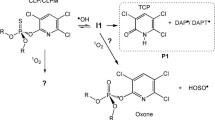Abstract
The nerve agent sarin has recently been deployed by terrorists in a major city. The molecule is volatile and made its way to many victims by passing as vapor through a highly reactive medium. Here we estimate rates and pathways for the removal of gas phase sarin from a generalized urban atmosphere. Only information from the open scientific literature is used. By structure reactivity comparisons with the organophosphorus pesticides, hydroxyl radical hydrogen abstraction may occur in as little as one hour. Decomposition of side chains after hydroxyl attack leads to organic oxygenates which preserve the phosphonofluoridate and so toxicity. The aqueous aerosol surface is contacted in minutes and offers access to a range of dissolved nucleophiles. Substitution displaces the fluoride leaving group, giving safe phosphoric acid analogs. Because of uncertainties in the electron distribution and in aqueous decay mechanisms, the time constants must be viewed as lower limits.
Similar content being viewed by others
References
Department of Commerce (1994): Technologies underlying weapons of mass destruction
Total Security Services International, Inc. (1997): Win against terrorism. TSSI, Inc., Centreville, VA
Ember, L. (1995): Details emerge of sarin attack by cult in Tokyo. Chem. & Eng. News73 (24) 2
Okumura, T.;Takasu, N.;Ishimatsu, S.;Miyanoki, S.;Mitsuhashi, A.;Kumada, K.;Tanaka, K. andHinohara, S. (1996): Report on 640 victims of the Tokyo subway sarin attack. Ann. Emerg. Med.28, 129–135
Harris, B.L.;Shanty, F. andWiseman, W.J. (1982): Chemicals in war. In: Encyclopedia of Chemical Technology (3rd Ed.)5, pp. 393–416, John Wiley & Sons, New York
Elliott, S.;Streit, G.E.;Gaffney, J.S.;Bossert, J.E.;Brown, M.;Reisner, J. andMcNair, L.A. (1999): Pathways for the oxidation of sarin in urban atmospheres, LA-13501-MS, Los Alamos National Laboratory, Los Alamos, New Mexico
Ministry for Foreign Affairs of Finland (1985): Development and evaluation of basic techniques, Part I. In: Air Monitoring as a Means for Verification of Chemical Disarmament, Chap. 2. MFAF, Helsinki
Barden, J.D. et al. (1993): Remote sensing technology and CW arms control. P650-1254G-1, 7, Kaman Sciences Corp., Alexandria, VA. (Feb 2, 1993)
Finlayson Pitts, B.J. andPitts, J.N. Jr. (1986) Atmospheric Chemistry: Fundamentals and Experimental Techniques. Wiley-Interscience, New York
Gearien, J.E. (1982): Cholinesterase inhibitors. In: Encyclopedia of Chemical Technology (3rd Ed.) 6, pp. 28–35, John Wiley & Sons, New York
Verweij, A.;Boter, H.L. andDegenhardt, C.E.A.M. (1979): Chemical warfare agents: verification of compounds containing the phosphorus-methyl linkage in waste water. Science204, 616–618 (May 11, 1979)
Metcalf, R.L. (1982): Insect control technology. In: Encyclopedia of Chemical Technology (3rd Edn) 13, pp. 413–485, John Wiley & Sons, New York
Winer, A.M. andAtkinson, R. (1990): Atmospheric reaction pathways and lifetimes for organophosphorus compounds. In: Long Range Transport of Pesticides (Edited byD.A. Kurtz), Chap 9. Lewis Publishers, Chelsea, MI
Gaffney, J.S.;Fajer, R.;Senum, G.I. andLee, J.H. (1986): Measurement of the reactivity of OH with methyl nitrate: implications for prediction of alkyl nitrate-OH reaction rates. Int. J. Chem. Kinet.18, 399–407
Atkinson, R. (1988): Estimation of gas-phase hydroxyl radical rate constants for organic chemicals. Environ. Toxicol. Chem.7, 435–442
Urban Air Pollution in Megacities of the World (1992): United Nations
Pandis, S.N.;Harley, R.A.;Cass, G.R. andScinfeld, J.H. (1992): Secondary organic aerosol formation and transport. Atmos. Environ.26A, 2269–2282
Ember, L. (1993): Chemical weapons: residues verify Iraqi use on Kurds. Chem. & Environ. News 8–10 (May 3, 1993)
Ward, J.R.;Hovanec, J.W.;Albizo, J.M.;Szafraniec, L.L. andBeaudry, W.T. (1991): Decomposition of phosphonofluoridates on glass. J. Fluorine Chem.51, 277–282
Daisey, J.M.;Ermak, D.L.;Policastro, A.J.;Streit, G.E. et al. (1997): Study and discussion of models applicable to the transport and fate thrust area of the Department of Energy chemical and biological nonproliferation program. LA-CP-166, Los Alamos National Laboratory, Los Alamos, New Mexico
Author information
Authors and Affiliations
Corresponding author
Rights and permissions
About this article
Cite this article
Elliott, S., Streit, G.E., Gaffney, J.S. et al. Pathways for the oxidation of sarin in urban atmospheres. Environ. Sci. & Pollut. Res. 6, 103–105 (1999). https://doi.org/10.1007/BF02987561
Received:
Accepted:
Issue Date:
DOI: https://doi.org/10.1007/BF02987561




